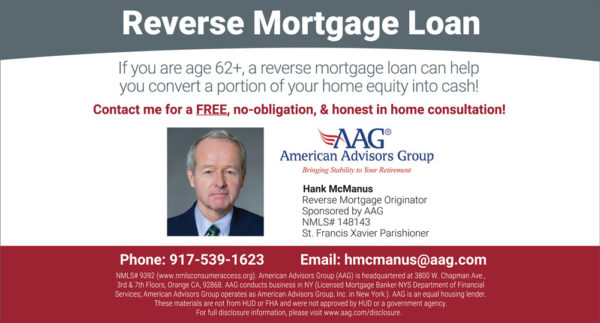As with many financial products, reverse mortgage loans can be misunderstood; and there are a number of misconceptions about how the product works.
Hank McManus is a local reverse mortgage professional for American Advisors Group (AAG), the country’s leading provider of reverse mortgages. Here he presents some of the myths and realities:
Myth No. 1 – The lender owns the home.
Like all mortgage loans, the reverse mortgage loan is secured by a lien, and you won’t lose your home as long as you continue to meet the loan obligations, which include: living in the home, maintaining the home according to Federal Housing Administration requirements, paying property taxes and paying homeowner’s insurance.
Myth No. 2 – Once loan proceeds are received, you pay taxes on them.
Like any loan, reverse mortgage proceeds are paid out tax-free as they are not considered income. However, it is recommended that you consult your financial advisor and appropriate government agencies for any effect on taxes.
Myth No. 3 – The borrower is restricted on how to use the loan proceeds.
The proceeds from a reverse mortgage loan can be used for any purpose. Many borrowers use it to supplement their retirement income, delay receiving Social Security benefits, pay off large expenses, pay for medical expenses, remodel their home or help adult children. You have worked hard for this asset, and prudence, along with budgeting, should be the proper approach to enjoying the proceeds.
Myth No. 4 – The home must be free and clear of any existing mortgages.
Actually, many borrowers use the reverse mortgage loan to pay off an existing mortgage and eliminate monthly mortgage payments. Paying off the existing mortgage and any other liens is required as part of the loan. It is the borrower’s responsibility to continue to pay for property taxes, homeowners insurance and home maintenance.
Myth No. 5 – Only people with financial hardships need reverse mortgages.
The perception that reverse mortgage loans are only for “financially strapped” borrowers is changing – affluent senior borrowers with multi-million dollar homes from Bayside to Bay Ridge and healthy retirement assets are using reverse mortgage loans as part of their financial and estate planning, and are working in conjunction with financial professionals and estate attorneys to enhance overall quality and enjoyment of life.
Looking to Supplement Retirement Savings?
Consider a reverse mortgage loan – a versatile retirement funding tool – to convert your home equity into cash. Reverse mortgage loan proceeds can be used to:
• Pay off an existing mortgage and eliminate monthly mortgage payments.
• Maintain a line of credit (that can grow) for health emergencies and other unexpected events.
• Get a monthly payment for life.
• Modify your home to accommodate aging in place.
• Convert a room or basement to a living facility for an aging relative or caregiver.
• Convert monthly expenses and hold onto other assets, while their value continues to grow.
• Cover monthly expenses and avoid selling assets at depressed value.
• Pay for health insurance during early retirement until Medicare eligible at 65.
• Combine life tenure payments with Social Security and income generated by assets to replace your salary.
• Pay for long-term health care needs.
• Maintain a standby cash reserve to get through the ups and downs of investment markets.
• Pay for short-term in-home care or physical therapy following an accident or medical incident.
• Fill the gap in retirement plan caused by lower than expected returns on assets.
• Set up transportation arrangements for when you are no longer comfortable driving.
• Create a set-aside to pay real estate taxes and property insurance.
• Delay Social Security benefits, increasing monthly payments later in life.
• Pay off credit card and other high interest debt.
• Cover monthly expenses between jobs without utilizing savings or other assets.
• Purchase health-related technology that enables you to be more independent.
• Travel to visit family and old friends.

